上教版六年级英语上册Unit5Animalsindanger第五单元第一课时教学设计
六年级英语上册 Unit 5 Animals in danger教案 牛津上海版
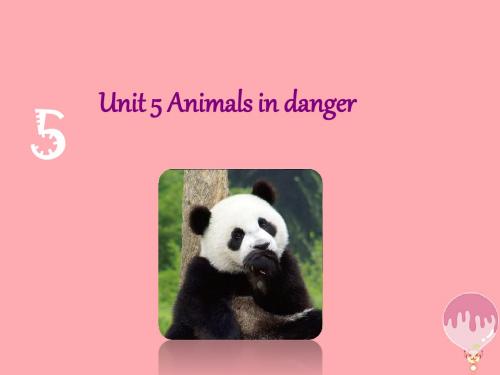
Steller’s sea cows(大海牛) lived near the shore. They liked swimming in cold sea water. They were black.
We must stop killing these animals for food, for their skin, or just for sport.
We cannot see some kinds of wild animals now.
Aurochs(欧洲野牛)lived in Europe. They were big and heavy. They looked like cows.
Dodos(渡渡鸟) lived on a little island. They were big birds with small wings. They were cute.
Talk about an animal:
This animal is in danger. In the past, there were … But now there are … They live … They have/had … We can … to save them.
What can we do to save the animals in danger?
These animals do not have enough food or clean water. We must help protect their homes.
These animals lost their homes because people cut down trees in the forests. We must help save the trees and forests.
上海教育版六年级英语上册unit 5《animals in danger
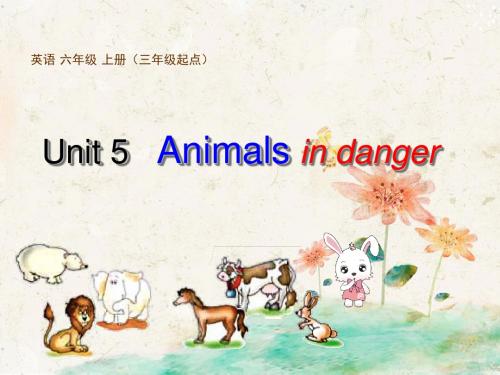
Listen,read and guess:
It has got four legs. It eats other animals . It is smaller than a tiger. It lives in Africa and Asia.
lion
small 小的——smaller较小的 The lion is smaller than a tiger.
1.The cow gives us ....m...i.l.k.... . 2.People can ride the...h..o..r.s..e...... . 3.The polar bear lives in the ..A..r.c..t.i.c... .
4.The elephant and the lion live in ...A..f.r.i.c..a...a..n..d...A..s..i.a....... . 5.The rabbit is ..s.m...a..l.l.e..r..t.h..a..n.... a sheep .
Oceania
Pacific Ocean
South America
Antarctica
Animals in the Arctic
Arctic fox
Arctic wolf
Arctic hare
A or B:
1.It has got ....A........... legs .
A.four B.two 2.It eats .......B............................ .
It has got four legs. It has got a long nose. It's a very big animal. It lives in Africa and Asia.
沪教版小学六年级英语上Unit 5 Animals in danger 教案
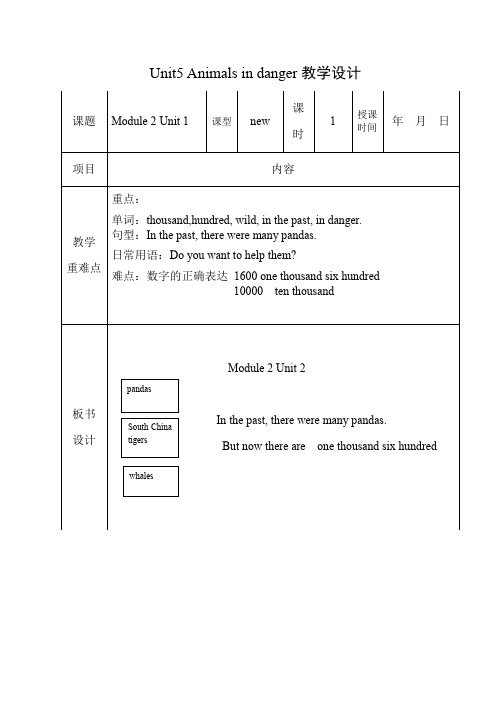
many
many
many
Now
1,600
30
10,000
In the past,there were…,but now there are only about…
Listen to the tape,and fill in the blanks.
Play the tape again,let them repeat.
S2: I can hear“tiger”.
…
Yes.Do youknowmany animals are in danger in the world.Some animals are less and less.(T draw a graph on the Bb) They are in danger. We should protect them.
Let Ss talk about the difference.Eg:
There were three students in the classroom. Now there are five students in the classroom. There was a table in front of the blackboard. Now there is no table in the class.….
Thousand neans ten hundred.
Read this two words.And say the rs.
100 tigers, 1000 South China tigers, 10000 whales
Pandas
South China tigers
Blue whales
六年级上册英语课件-Unit 5《Animals in danger》_牛津上海版 (共18张PPT)
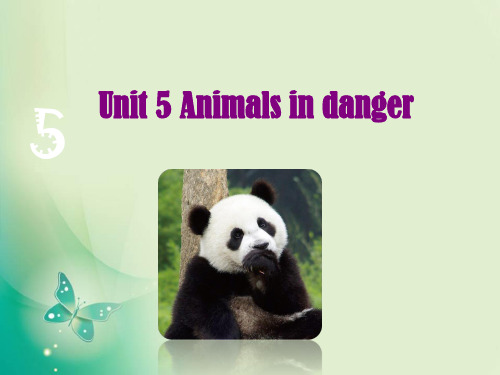
Talk about an animal:
This animal is in danger. In the past, there were … But now there are … They live … They have/had … We can … to save them.
What can we do to save the animals in danger?
5 Unit 5 Animals in danger
What’s your favourite animal?
Are these animals in danger?
There were many …, but now there are only about … in the wild.
In the past, there were many pandas, but now there are only about one thousand six hundred pandas in the wind.
Steller’s sea cows(大海牛) lived near the shore. They liked swimming in cold sea water. They were black.
We must stop killing these animals for food, for their skin, or just for sport.
We cannot see some kinds of wild animals now.
Aurochs(欧洲野牛)lived in Europe. They were big and heavy. They looked like cows.
沪教牛津版深圳用英语六年级上册Unit 5 Animals in danger Period 1课件
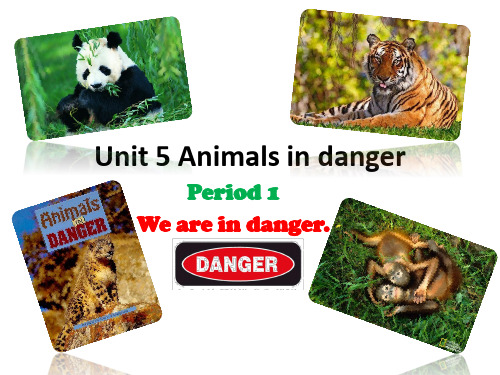
You help me, I remember you.
• 1.如何记忆hundred和 thousand这两个单词和其用 法?
• 2.如何用There be句型来对比 In the past, t过her去e w和as/现we在re.存.. 在no的w t事her物e i?s/are...
• 3.How can we protect the animals?
We need clean water!
1.Why are the animals in danger? 2.What can we do to help?
(Find out the problems)
(Ways to deal with the problems)
Watch Think
1.Why are wild animals in danger?
now there are thousnads
_n_o_/_n_o__t_a_n_y___ rubbish, of tons of rubbish.
Think
Pair
Share
But
__________, there were ______________gorillas. They lived happily.
What can it do:climb trees ( )
play chess
()
read books
()
count numbers ( )
Can you count like me?
You can try!
one two three four five six seven eight nine ten
do to help?(optional)
牛津上海版(三起)六年级上册英语 Module 2 Unit 5 Animals in danger【第一课时】教学设计
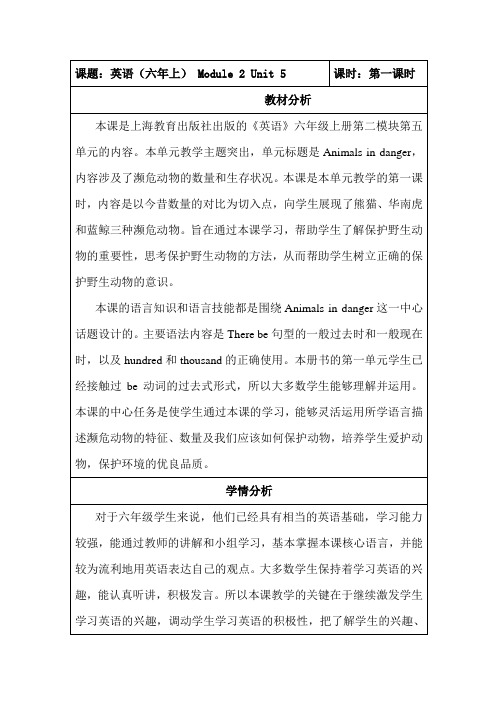
Introduce the new friend to Ss. Thenget on the internet. Ask Ss to try to answer the questions.【What is WAP? What do people do in WAP?】
变化;
◇教学难点
正确使用一般过去时和一般现在时对事物的今昔变化进行综合描述。
教学基本策略及设计思路
本课教学设计关注了英语学科的工具性和人文性双重性质,秉着面向全体学
生、关注差异的原则,结合单元整体设计的理念,整体设计了目标,充分挖掘了教材内容,再构了文本,并充分考虑语言学习的渐进性和特殊性,关注学生的参与、体验和感知,努力创设真实的情境和真实的语用任务,让学生在用英语描述事物的过程中理解和运用语言。同时优化了评价方式,也为学生提供了更多的交流平台和展示机会,以培养其综合语言运用能力。
学情分析
对于六年级学生来说,他们已经具有相当的英语基础,学习能力较强,能通过教师的讲解和小组学习,基本掌握本课核心语言,并能较为流利地用英语表达自己的观点。大多数学生保持着学习英语的兴趣,能认真听讲,积极发言。所以本课教学的关键在于继续激发学生学习英语的兴趣,调动学生学习英语的积极性,把了解学生的兴趣、动机作为突破点,分析学生已有的知识水平和能力水平,从学生的心理特点、认知规律和生活经验出发,并根据教材提供的主题进行设计,进行文本再构,引导学生积极思考和积极发言,从而创造以学生为中心的课堂学习氛围,全面培养学生听、说、读、写及综合运用语言的能力。
II.
Presentation
&Learning
1. Watch and think
Show some photos of
六年级上册英语(牛津上海版)Unit 5 Animals indanger课件
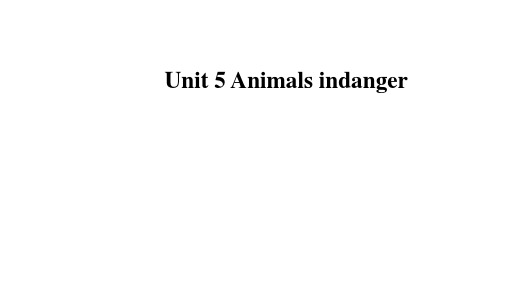
4. Elsa grew up and learnt a lot. 艾尔莎长大了并且学会了许多。
learn的意思是“学习,学会”,侧重学习的成果,指从不 知到知,从不会到会的学习,强调通过学习去获得知识和技 能,它没有凭勤奋努力而获得知识的意味。
learn亦可指向某人学习,从某处学习一门技能等。
常用短语: learn sth. 学习某事 learn sth. from... 从……学习某事 learn about 了解;学习 learn by oneself 自学
2 In the article, we learn about_______ animals.
a three
b four
c six
3 The title of the article can be________. a “Lovely animals” b “Animals in the past” c “Wild animals in danger”
240、:3敏17而.1好4.学20,20不20耻:3下17问.1。4.。2072.01240.2:03210270.:1341.:2401270.1240.:230122002:301:32107:3.114:4.2102200:31:41
春去春又回,新桃换旧符。在那桃花盛开的地方, 45、不海要内为存它知的已结,束天而涯哭若,比应邻当。为Tu它es的da开y,始Ju而ly笑14。, 72.01240.2J0u2ly0270.1T4u.2e0sd2a0y2,0J:3u1ly201:43,122002:3017:/41142/200:2301:41 在这醉人芬芳的季节,愿你生活像春天一样阳光,心情 56、莫生愁命前的路成无长知,已需,要天吃下饭谁,人还不需 识要 君吃 。苦8时,3吃1分亏8。时T3u1e分sd1a4y-J, uJlu-2ly0174.1,42.022002J0uly 20Tuesday, July 14, 20207/14/2020
牛津上海版(三起)2020-2021学年六年级英语上册Unit 5 Animals indanger课件

book cook foot put full look pull
亲亲爱爱的的读读者者:: 1、学盛生而年活不思重相则来信罔,眼,一泪思日,而难眼不再泪学晨并则。不殆及代。时表宜软20自弱.7.勉。12,270.岁.172.月1.22不072.待1020人.92:。025。00929:00:.0575:.010329J7:0u.15l-2:20.02300J92u:0l0-02590:0095:095:05:03Jul-2009:05 春亲去爱春的又读回者,: 2、一千世年里上之没计行有在,绝于始望春于的,足处一下境日。,之只20计有20在对年于处7月晨境1。绝2日二望星〇的期二人日〇。年二七〇月二十〇二年日七月20十20二年日7月201220日年星7月期1日2日星期日 春去春又回,新新桃桃换换旧旧符符。。在在那那桃桃花花盛盛开开的的地地方方,,在在 3、莫少成等年功闲易都,学永白老远了难不少成会年,言头一弃,寸空光放悲阴弃切不者。可永轻远09。不:05。会7成0.192功:0.25。072.1020.92:025070.192:0.25072.1020.92:0250099:0:055:00397:0.152:0.23072.1020.92:025070.192:0.25072.102.2020
4. Elsa grew up and learnt a lot. 艾尔莎长大了并且学会了许多。
learn的意思是“学习,学会”,侧重学习的成果,指从不 知到知,从不会到会的学习,强调通过学习去获得知识和技 能,它没有凭勤奋努力而获得知识的意味。
learn亦可指向某人学习,从某处学习一门技能等。
常用短语: learn sth. 学习某事 learn sth. from... 从……学习某事 learn about 了解;学习 learn by oneself 自学
上教版六年级英语上册M2 Unit 5 Animals in danger第二模块第五单元优秀教案

M2 U5 Animals in danger上海教育出版社《英语》六年级上册性。
Summary andhomework(3 minutes)总结板书,提出思想主题升华。
Let’s help the animalsand make a wonderfulworld.学生读句子,树立“保护动物”的意识。
对学生进行思想教育,使学生情感在语言习得的过程中得到升华。
布置作业。
Do a survey.(P34濒危动物调查)学生了解作业要求。
将课堂所学内容延伸到课外,进一步加强学生的自主学习能力。
板书设计M2U5 Animals in dangerIn the past, there were…But now, there are…教师的课后反思这节课的教学中我围绕着一条教学主线Animals in danger,开展各项语言学习活动,并通过它进行发散与拓展。
采用任务型教学,从听说入手,创设情景,设计调查与游戏,激发学生学习兴趣;所设计的活动面向全体学生,由易到难,让学生在愉快的氛围中从不同程度得到提升,最终实现语用的目的。
这节课我首先通过谈话、让学生讲述暑假经历,以教师的日记激活学生已有的背景知识,温故知新。
然后让学生猜数字,引发悬念,习得含有百和千的数字读法。
启发学生的创造性思维,生成自己的语言素材。
运用有关动物的一段视频恰当导入, 激发学生的求知欲和学习兴趣,同时引出本课主题:濒危动物。
在课文的讲授中,通过听录音、填表格、读课文、问答等形式,将课文学习与语言技能进行整合,对学生进行综合语言技能训练以及学习策略的渗透。
课后操练,我让学生根据表格制作濒危动物档案,不仅强化了本课重点,还突破了难点。
最后让学生一起动脑、动手,想一想、写一写保护濒危动物的方法,做到思想目标的提升。
本课的作业是做濒危动物调查报告, 使本课的英语学习延伸到学生对事物的探索中,实现语篇学习的目标, 鼓励学生将所阅读的内容与自己的经历、知识、兴趣和观点相联系,最终实现学生综合语言能力的提高。
六年级英语上册Unit5Animalsindanger第1课时教案牛津上海版深圳用

Animals in dangerC.hundredofD.A and BStep 3 Ask and answer(1)In the past ,how many pandas were there ? (2)How many pandas are there now ?(3)In the past ,how many South China tigers were there ?(4)How many South China tigers are there now ? (5)How many blue whales are there now ? Step 3 Circle the correct answers.Step 4科普《世界自然爱护联盟》对受危物种的分级 绝灭(Ex ):指野生状态下已经绝迹,但人工饲养或放养的尚有残存,如麋鹿。
国内绝迹(Ex ):指国内野生状态的已经绝迹,国外尚有野生的,如高鼻羚羊。
濒危(E ):野生种群数量已降低到面临灭亡或绝迹的临界程度,且致危因素仍在接着,如朱鹮、华南虎。
易危(V ):野生种群数量明显下降,如不实行有效爱护措施,势必沦为"濒危"者,或因接近某"濒危"级别,而必需予以爱护以确保"濒危"种的生存,如金猫、云豹。
稀有(R ):从分类订名以来,总共只有为数有限的发觉纪录者,如沟牙鼯鼠。
内容完成此题学生依据课文内容完成此题学生牢记科普学问检测学生对课文的驾驭程度,达到课文、单词和语法同步学习的目的。
检测学生对课文的驾驭程度扩高校生的视野,更好的了解爱护濒危动物的重要性。
不足(I):状况不甚明显,但有迹象表明可能属于或疑为濒危或趋危者,如普氏原羚、假吸血蝠。
Step 5Do you know these animal?African elephant 非洲象非洲象属是象科的一个属,于1825年由乔治·库维叶男爵(Baron Georges Cuvier)命名。
上海沪教牛津版小学六年级英语上册Unit 5 习题及答案
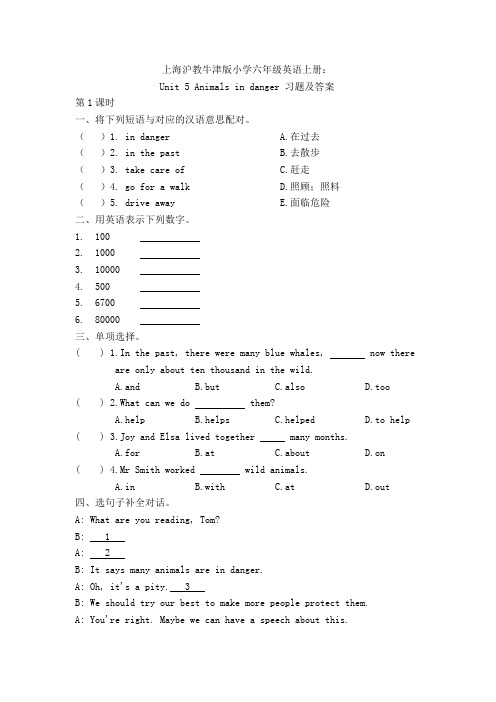
上海沪教牛津版小学六年级英语上册:Unit5Animals in danger习题及答案第1课时一、将下列短语与对应的汉语意思配对。
()1.in danger A.在过去()2.in the past B.去散步()3.take care of C.赶走()4.go for a walk D.照顾;照料()5.drive away E.面临危险二、用英语表示下列数字。
1.1002.10003.100004.5005.67006.80000三、单项选择。
()1.In the past,there were many blue whales,now there are only about ten thousand in the wild.A.andB.butC.alsoD.too()2.What can we do them?A.helpB.helpsC.helpedD.to help ()3.Joy and Elsa lived together many months.A.forB.atC.aboutD.on()4.Mr Smith worked wild animals.A.inB.withC.atD.out四、选句子补全对话。
A:What are you reading,Tom?B:1A:2B:It says many animals are in danger.A:Oh,it's a pity.3B:We should try our best to make more people protect them.A:You're right.Maybe we can have a speech about this.B:4A.What does it say?B.That's a good idea.C.I'm reading a book about animals.D.What should we do?1. 2. 3. 4.第2课时一、将图片与动物的名称对应连线。
小学六年级英语Unit 5 Animals in danger教学设计
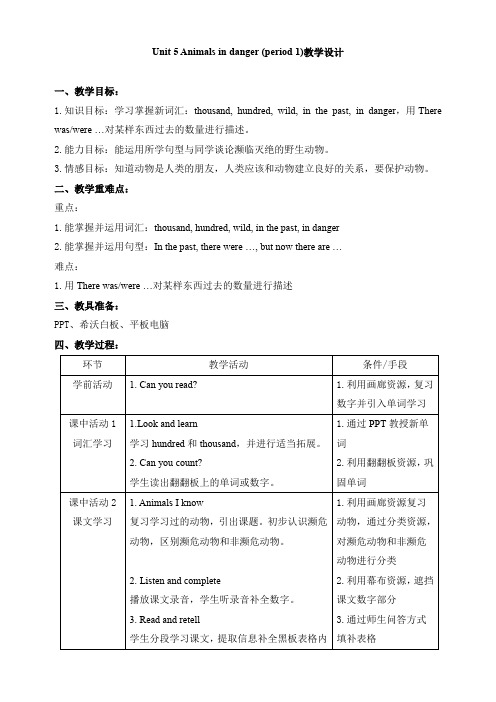
Unit 5 Animals in danger (period 1)教学设计
一、教学目标:
1.知识目标:学习掌握新词汇:thousand, hundred, wild, in the past, in danger,用There was/were …对某样东西过去的数量进行描述。
2.能力目标:能运用所学句型与同学谈论濒临灭绝的野生动物。
3.情感目标:知道动物是人类的朋友,人类应该和动物建立良好的关系,要保护动物。
二、教学重难点:
重点:
1.能掌握并运用词汇:thousand, hundred, wild, in the past, in danger
2.能掌握并运用句型:In the past, there were …, but now there are …
难点:
1.用There was/were …对某样东西过去的数量进行描述
三、教具准备:
PPT、希沃白板、平板电脑
四、教学过程:
五、板书设计:
Unit 5 Animals in danger
Pandas South China tigers Blue whales In the past many many many Now 1,600 30 10,000
In the past, there were many pandas,
but now there are one thousand six hundred pandas.
We should stop killing the animals.。
六年级上册英语课件-Unit 5《Animals in danger》_牛津上海版 (共18张PPT)

We cannot see some kinds of wild animals now.
Aurochs(欧洲野牛)lived in Europe. They were big and heavy. They looked like cows.
Dodos(渡渡鸟) lived on a little island. They were big birds with small wings. They were cute.
Talk about an animal:
This animal is in danger. In the past, there were … But now there are … They live … They have/had … We can … to save them.
What can we do to save the animals in danger?
In the past, there were many South China tigers, but now there are only about one thirty in the wind.
In the past, there were many blue whales, but now there are only about ten thousand in the wind.
Steller’s sea cows(大海牛) lived near the shore. They liked swimming in cold sea water. They were black.
We must stop killing these animals for food, for their skin, or just for sport.
Unit 5 Animals in danger 第1课时+示范教案(六上)
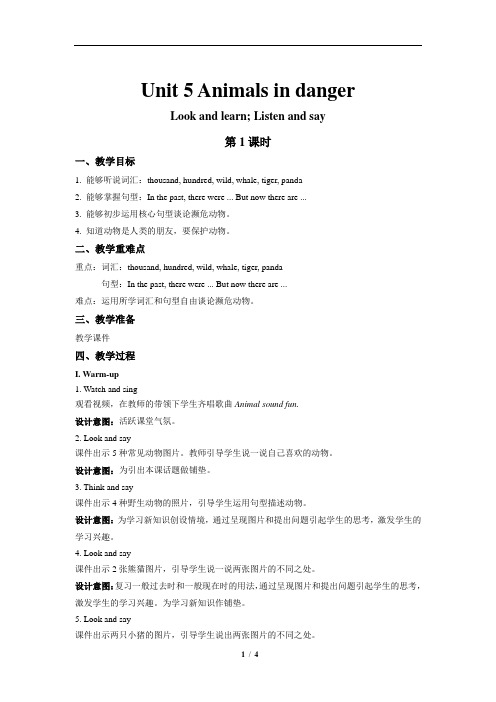
Unit 5 Animals in dangerLook and learn; Listen and say第1课时一、教学目标1. 能够听说词汇:thousand, hundred, wild, whale, tiger, panda2. 能够掌握句型:In the past, there were ... But now there are ...3. 能够初步运用核心句型谈论濒危动物。
4. 知道动物是人类的朋友,要保护动物。
二、教学重难点重点:词汇:thousand, hundred, wild, whale, tiger, panda句型:In the past, there were ... But now there are ...难点:运用所学词汇和句型自由谈论濒危动物。
三、教学准备教学课件四、教学过程I. Warm-up1. Watch and sing观看视频,在教师的带领下学生齐唱歌曲Animal sound fun.设计意图:活跃课堂气氛。
2. Look and say课件出示5种常见动物图片。
教师引导学生说一说自己喜欢的动物。
设计意图:为引出本课话题做铺垫。
3. Think and say课件出示4种野生动物的照片,引导学生运用句型描述动物。
设计意图:为学习新知识创设情境,通过呈现图片和提出问题引起学生的思考,激发学生的学习兴趣。
4. Look and say课件出示2张熊猫图片,引导学生说一说两张图片的不同之处。
设计意图:复习一般过去时和一般现在时的用法,通过呈现图片和提出问题引起学生的思考,激发学生的学习兴趣。
为学习新知识作铺垫。
5. Look and say课件出示两只小猪的图片,引导学生说出两张图片的不同之处。
设计意图:复习一般过去时和一般现在时的用法,通过呈现图片和提出问题引起学生的思考,激发学生的学习兴趣。
为学习新知识作出铺垫。
II. Presentation1. Look and learn课件出示老虎,熊猫和鲸鱼的图片,引导学生学习和复习重点单词:tiger, panda, whale, 以及wild名词和形容词的用法。
学科信息:英语-上教版(三起)-六年级上Unit 5 Animals in danger

In the past,
there were many South China tigers, but now there are only about thirty in the wild.
•
•
Animals are in danger now!
•
Make a report!
(Each group a student)
沪教版六年级上册第五单元第一课时
Unit 5 Animals in danger
Period One
Play a game: Turntable game
转盘游戏规则 1、每名同学一组,全班分成5组。
2、转盘转动选出任务及组别,选出的组要完成相应任务。 3、每组推选组内同学完成任务,全部正确得30分。
.. are .... They are .... They eat ... They live in the wild. In the past, there were many ... but now there are only about ... in the wild. They are in danger.
3, How many blue whales were there in the past?
In the past , there were many blue whales .
In the past, there were many pandas. They were black and white. They were round and cute. They ate bamboo. They lived in the jungle.
4、根据每组完成任务的表现,得到最高分的组获得胜利。
六年级上册英语Unit-5《Animals-in-danger》牛津上海版
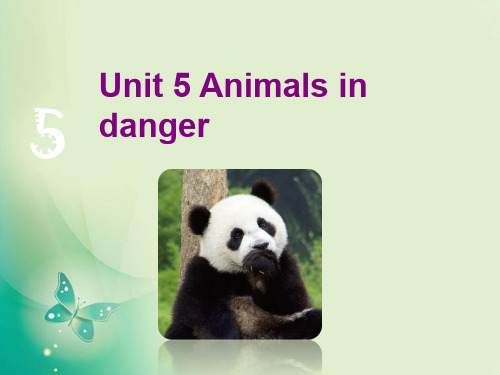
Steller’s sea cows(大海牛) lived near the shore. They liked swimming in cold sea water. They were black.
We must stop killing these animals for food, for their skin, or just for sport.
These animals do not have enough food or clean water. We must help protect their homes.
These animals lost their homes because people cut down trees in the forests. We must help save the trees and forests.
Homework
• Find an animal that is in danger and talk or write about it.
• Finish ook pages 27 and 29.
谢谢聆听!
We cannot see some kinds of wild animals now.
Aurochs(欧洲野牛)lived in Europe. They were big and heavy. They looked like cows.
Dodos(渡渡鸟) lived on a little island. They were big birds with small wings. They were cute.
In the past, there were many South China tigers, but now there are only about one thirty in the wind.
六年级上册英语课件-Unit 5《Animals in danger》_牛津上海版 (共18张PPT)

Steller’s sea cows(大海牛) lived near the shore. They liked swimming in cold sea water. They were black.
We must stop killing these animals for food, for their skin, or just for sport.
Talk about an animal:
This animal is in danger. In the past, there were … But now there are … They live … They have/had … We can … to save them.
What can we do to save the animals in danger?
In the past, there were many South China tigers, but now there are only about one thirty in the wind.
In the past, there were many blue whales, but now there are only about ten thousand in the wind.
Homework
1. Find an animal that is in danger and talk or write about it.
2. Finish Workbook pages 27 and 29.
谢谢聆听!
These animals do not have enough food or clean water. We must help protect their homes.
- 1、下载文档前请自行甄别文档内容的完整性,平台不提供额外的编辑、内容补充、找答案等附加服务。
- 2、"仅部分预览"的文档,不可在线预览部分如存在完整性等问题,可反馈申请退款(可完整预览的文档不适用该条件!)。
- 3、如文档侵犯您的权益,请联系客服反馈,我们会尽快为您处理(人工客服工作时间:9:00-18:30)。
◊文化意识目标让学生感受中西方文化的的相同和不同,加深对中外文化的理解,逐步形成跨文化意识。
教学重点及难点◊教学重点1、能正确地理解、运用词汇和词组wild, hundred, thousand, in the past, indange;2、能运用There be句型的一般过去时和一般现在时描述濒危动物今昔数量的变化;◊教学难点正确使用一般过去时和一般现在时对事物的今昔变化进行综合描述。
___________教学基本策略及设计思路 __________________________ 本课教学设计关注了英语学科的工具性和人文性双重性质, 秉着面向全体学生、关注差异的原则,结合单元整体设计的理念,整体设计了目标,充分挖掘了教材内容,再构了文本,并充分考虑语言学习的渐进性和特殊性,关注学生的参与、体验和感知,努力创设真实的情境和真实的语用任务,让学生在用英语描述事物的过程中理解和运用语言。
同时优化了评价方式,也为学生提供了更多的交流平台和展示机会,以培养其综合语言运用能力。
在本课的教学过程中,采用了以下策略:导入策略---- 通过Brainstorming活动让学生说出自己对wild animal的认知,从而引出本课主题,关注了语言学习的实践性和应用性;认知策略一一借助图片、视频等多种手段增强学生对新知的感知,帮助学生感受濒危动物数量的减少和我们肩负保护动物的使命;技能策略-- 通过WatCh and think. Read and answer. Look, listen and circle. Read and match. Look and say. Thi nk and write.等一系列的活动关注了对学生听、说、读、写能力以及综合运用语言能力的培养;交际策略一一学生在师生、生生、小组互动中,学习倾听、参与活动,互相配合,表达自己的观点;分层策略一一本课在一些活动的的设计上充分考虑了学生的学习兴趣、学习能力以及学习方法等多方面的不同,并给予一定的帮助和提示,为每个学生提供适合的教育;写作策略一一通过对语言框架的梳理,引导学生从口头表达向书面表达过度。
评价策略课堂上运用多种评价方式对学生的语言知识、语言技能和语言运用水平进行评价,使之更加积极地进行英语学习。
资源的开发及说明◊文本资源根据教材提供的简单文本,提炼出In the past, there Were-, but now there are∙∙ 这一核心语言,并充分挖掘教材内涵,重新再构文本。
同时通过再构的文本,帮助学生从野生动物的外貌特征、生活习性和居住地等方面全方位了解濒危野生动物的现状,并帮助学生了解保护野生动物的重要性,思考保护野生动物的方法,从而帮助学生树立正确的保护野生动物的意识。
通过再构文本让学生感SS to try to anSWer the questions.【What is WAP? What do people do in WAP?3. Look and Say ASk SS to look at the photos and read the n ews on the intern et. TeaCh the new PhraSe.【South China tiger 】4. Show the title 【Wild animals in danger】5. Lear n and Saya. Show SS a photo of the red wolves and two nu mbers. ASk SS to guess how many red wolves there are now in the wild.b. TeaCh the new words. 【hundred, thousa nd】c. Show SS some numbers.【200 ,365, 1600…】together to …】Lear n and talk. Thenread the n ews and fillin the form. Report.【They are SouthChina tigers. They arebig and strong. Theylive in the forest inSouth China. They eatmeat. There are onlyabout 30 in the wild now.】Read together.GUeSS the number.【In the past, thereWere many red wolves,but now there are onlyabout …in the wild.]Lear n to say.Try to Say in En glish.【two hun dred,three hun dred andsixty- five, one thousand SiX hun dred∙∙J向学生渗透WAP的相关内容,让学生感受中西方文化的相同和不同,从而形成跨文化意识。
学生利用自己已有的知识谈论华南虎,实现了英语学习的工具性和交际性。
通过阅读网站上的新闻完成表格,也是对学生阅读策略的指导。
再帮助学生梳理出本课的语言框架,为后面的语用输出做好准备。
通过呈现学生不熟悉的濒危野生动物图片,帮助学生加深了解,提高保护动物的意识和紧迫感。
通过猜现有数量引出本课核心词汇hundred 和thousand,并完成相应的学习。
通过呈现几组有代表性的数字,帮助学生及时理解和运用,并内化知识。
6. Look and Say Show SS some photos of wild animals in dan ger and the SentenCe Patter n.7. Look, listen and CirCIeShow SS the text and questi ons on P31.8. LiSte n and imitatea. ASk SS to liste n and imitate.b. ASk SS to PraCtiCe by themselves.c. ASk SS to read thetext together.Talk about the wild animals in dan ger USingthe SentenCe Pattern.Look at the text, listento the record andCirCIe the COrreCt answers. The n report.LiSte n and imitate.Practice.Read together.大量的濒危野生动物的图片对学生又是一种警示,同时也让学生完成了核心句型和词汇的操练。
把课文作为阅读文本,让学生完成书上的三个选择题,在理解课文的基础上再次强化核心语言。
通过听音、模仿,完成对学生读能力的训练。
1. Thi nk and talka. Show the photos of the blue Whales. ASk SS to try to talk about accord ing to the handwriting on the board.b. ASk SS to talk about the Pan das.2. Watch, thi nk Talk about the blue Whales.【They are blue Whales. They are big and cute. They livein the sea/ocea n.They eat fish. In thePaSt there Weremany, but now thereareonly about tenthousa nd in thewild.]Talk about thePan das.Watch, think and say.利用板书上的文本框架,让学生根据自己对blue WhaIeS 的了解进行完整的描述。
使学习提升了一个高度,South Chinatigers的目的是为了梳理出语言框架,而此处是用梳理出的语言框架进行输出描述,完成了从学习到语用的过渡。
再谈论熊猫,则是再进一步的提升和强化。
In .COn solida- tio n &EXte nsionand say.a. ShOW SS a short video that Julie sent. 【Why are the wild ani mals in dan ger?]b. Lead in “ We shouldn' CUt down trees. We shouldn' kill ani mals. We shouldn' pollute the land, the Water and the air.3. Read a poem Show SS a poem that Julie wrote and read it for Ss.4. Thi nk and write. ASk SS to turn the Card over and Write a small compositi on. Then StiCk the CardS on the board. 【People CUt downtrees, so ani mals lose their homes. Peoplekill ani mals, so animals die. People pollute the land, the Water and the air, so ani mals have no food.]Read together.Read the poem together.Write and report. 通过小视频帮助学生了解野生动物濒危的原因,引起共鸣,并运用简单的句式描述人类的罪行,以及我们应该做或是不应该做的事情,从而培养学生爱护动物,保护环境的优良品质。
把教材上的文本和教师再构的文本进行变形,以小诗的形式向学生展现濒危动物的现状和人类应该如何改变这种现状,语言简洁,意义深远。
作为奖励的小卡片背面有濒危动物的图片和信息,学生完成书面书写,触及到他们已有的生活经验和学习体验,又关注到核心语言基础的扩展、迁移和串连,学生正是在这种重复、循环、发展、提高的过程中进行学习,从而使得他们的综合运用语言能力呈螺旋式上升。
做到语用输出,有度有序。
学生学习活动评价设计本课教师探索促进学生发展的多种评价方式,通过多元化的评价方式,不但 评价了学生的语言运用水平,而且又通过评价激励学生继续学习。
